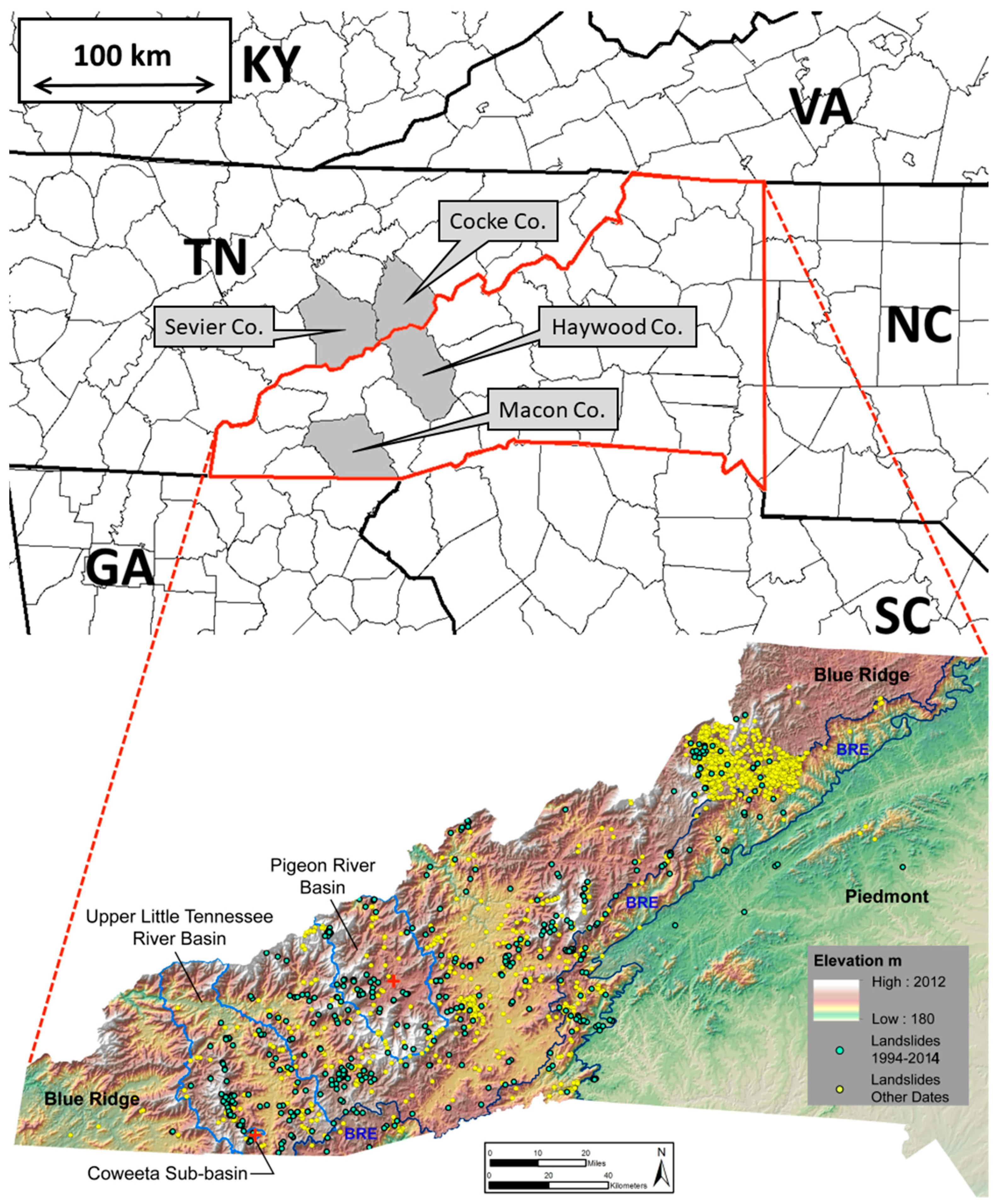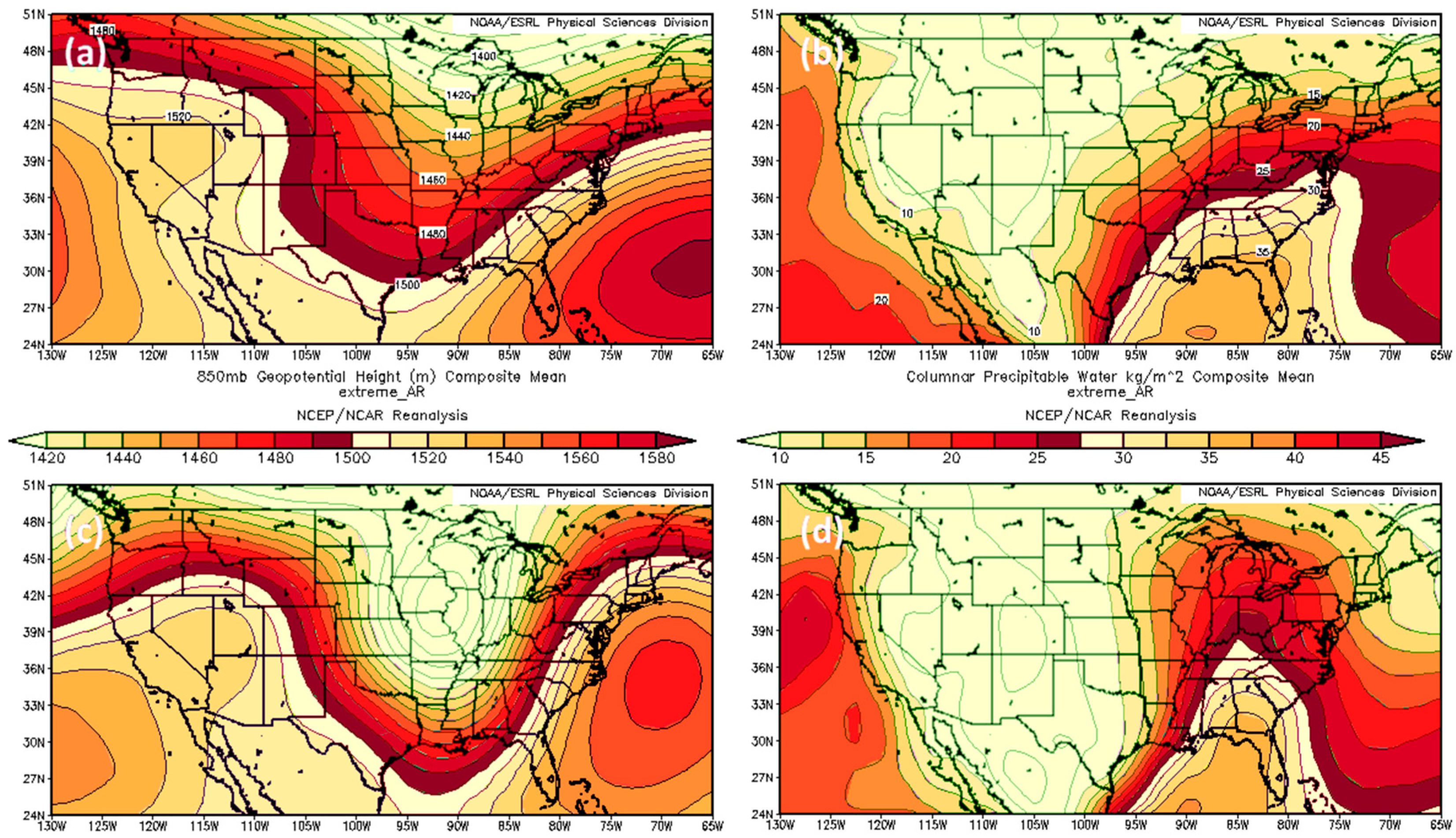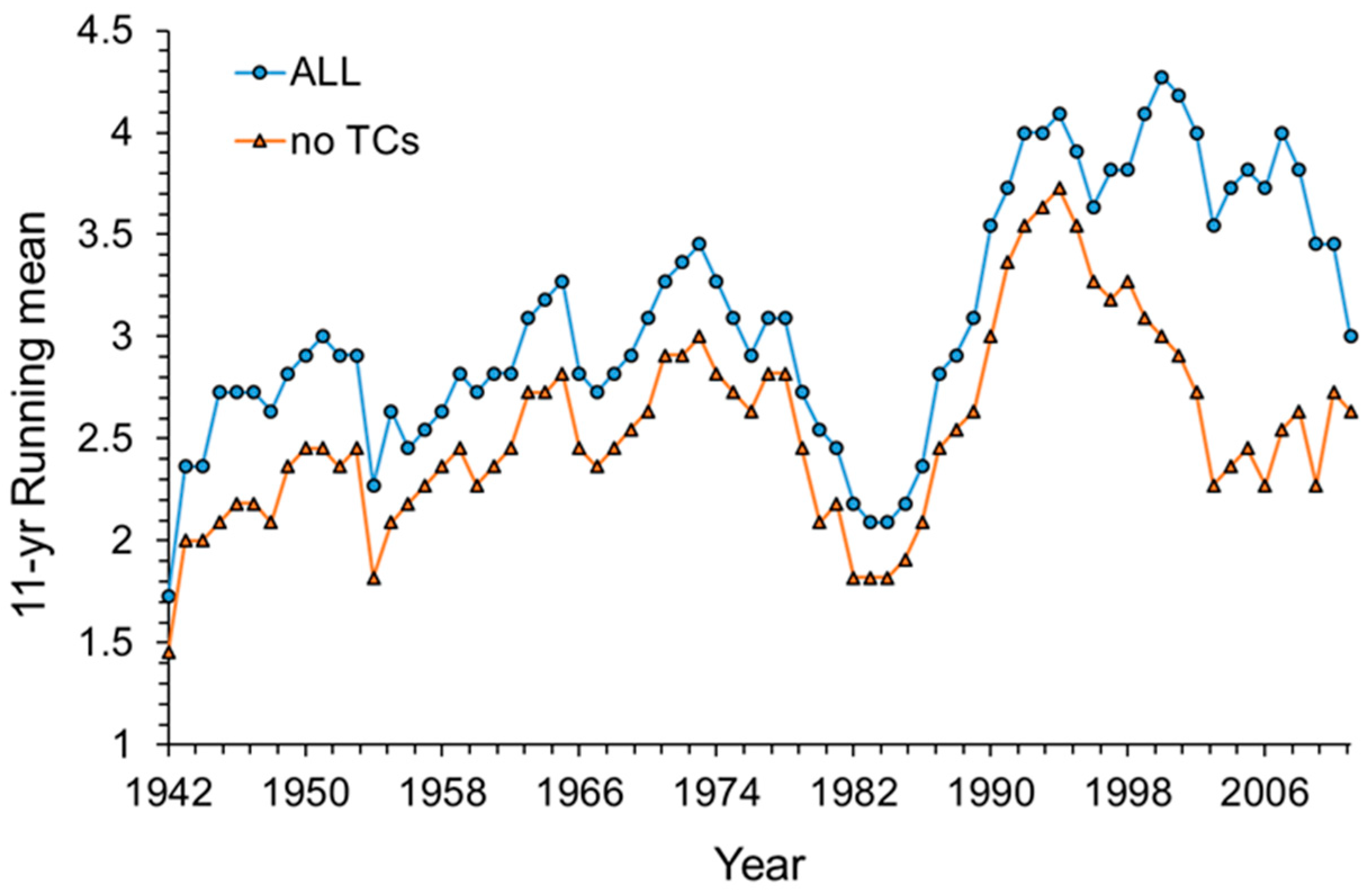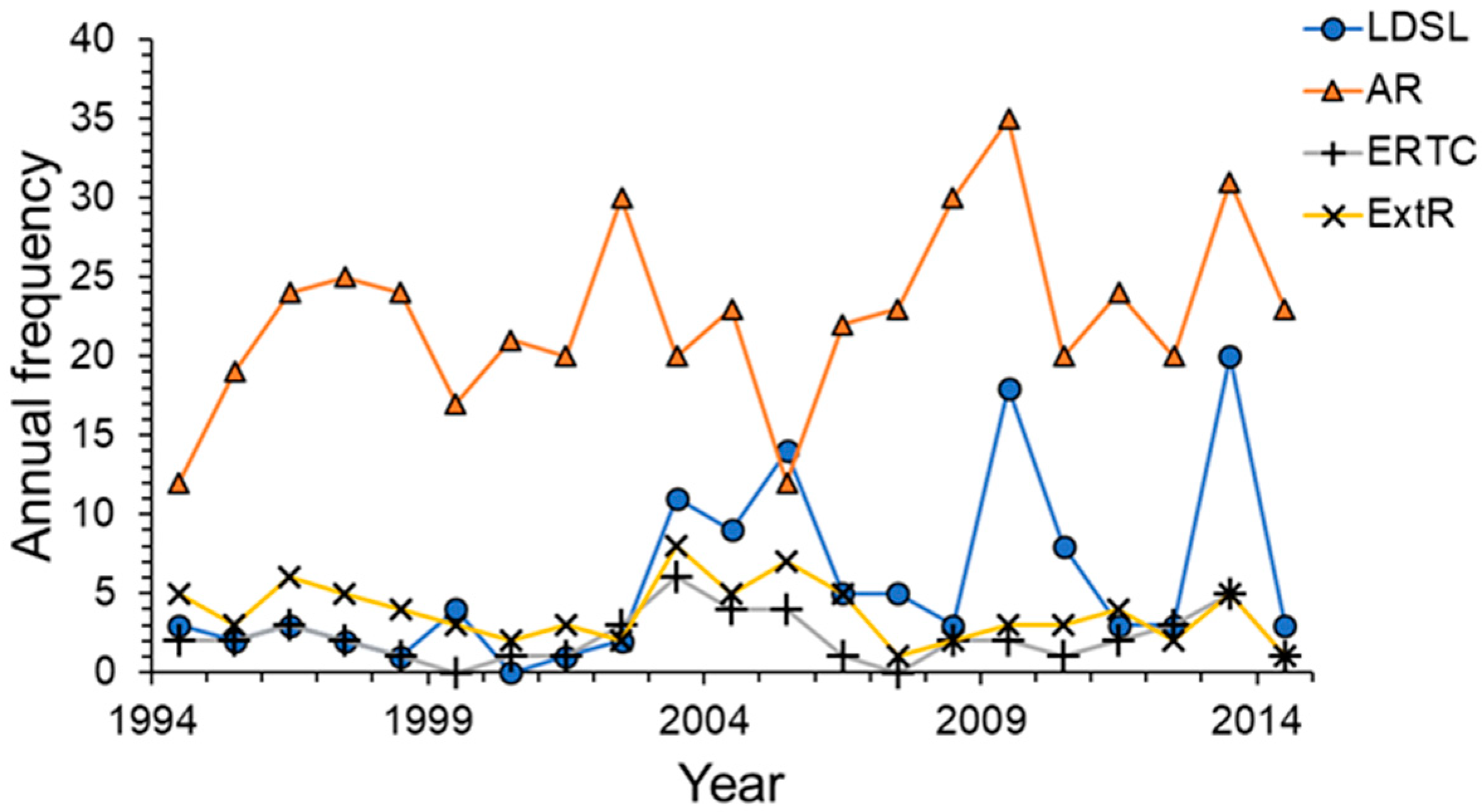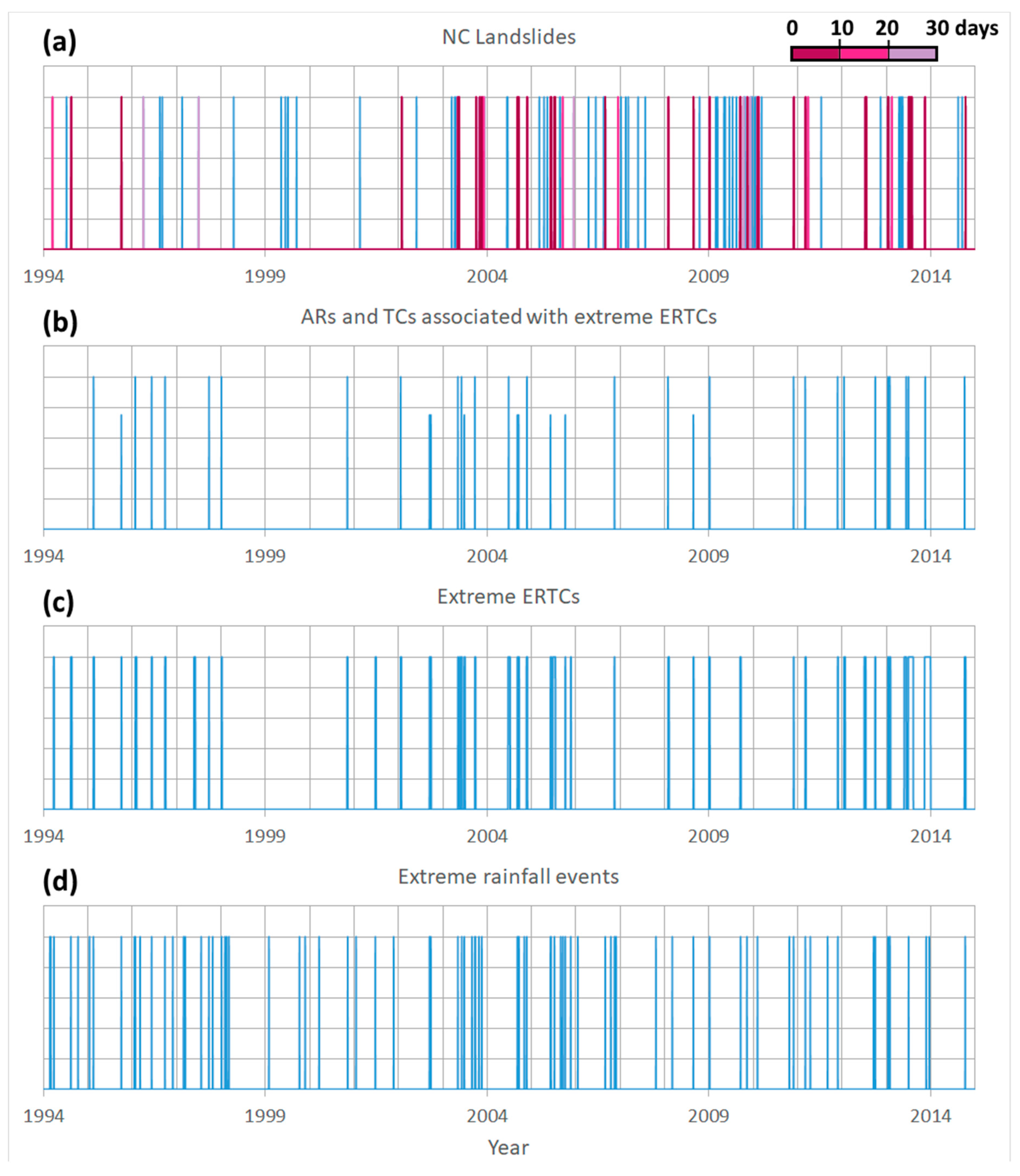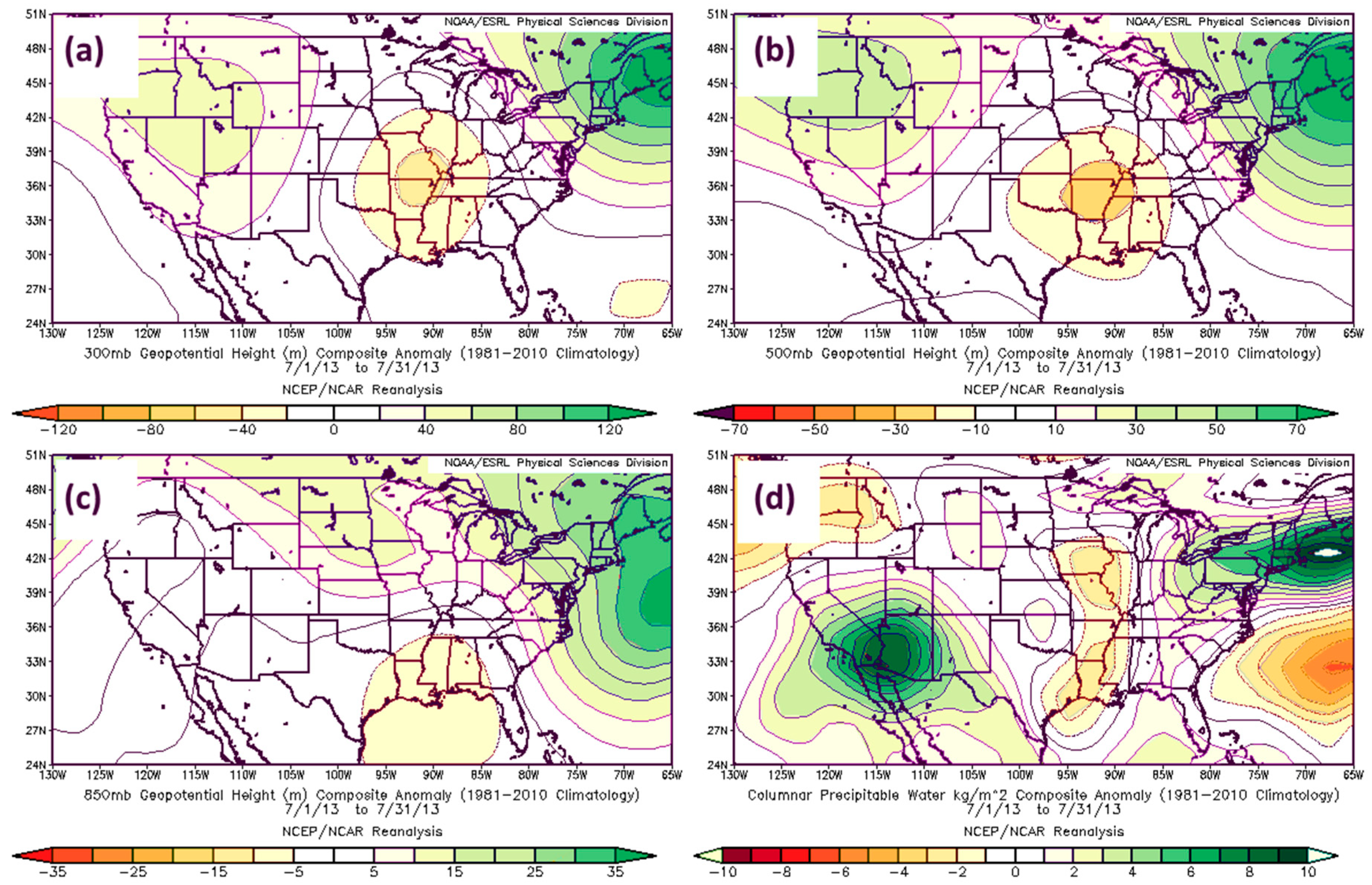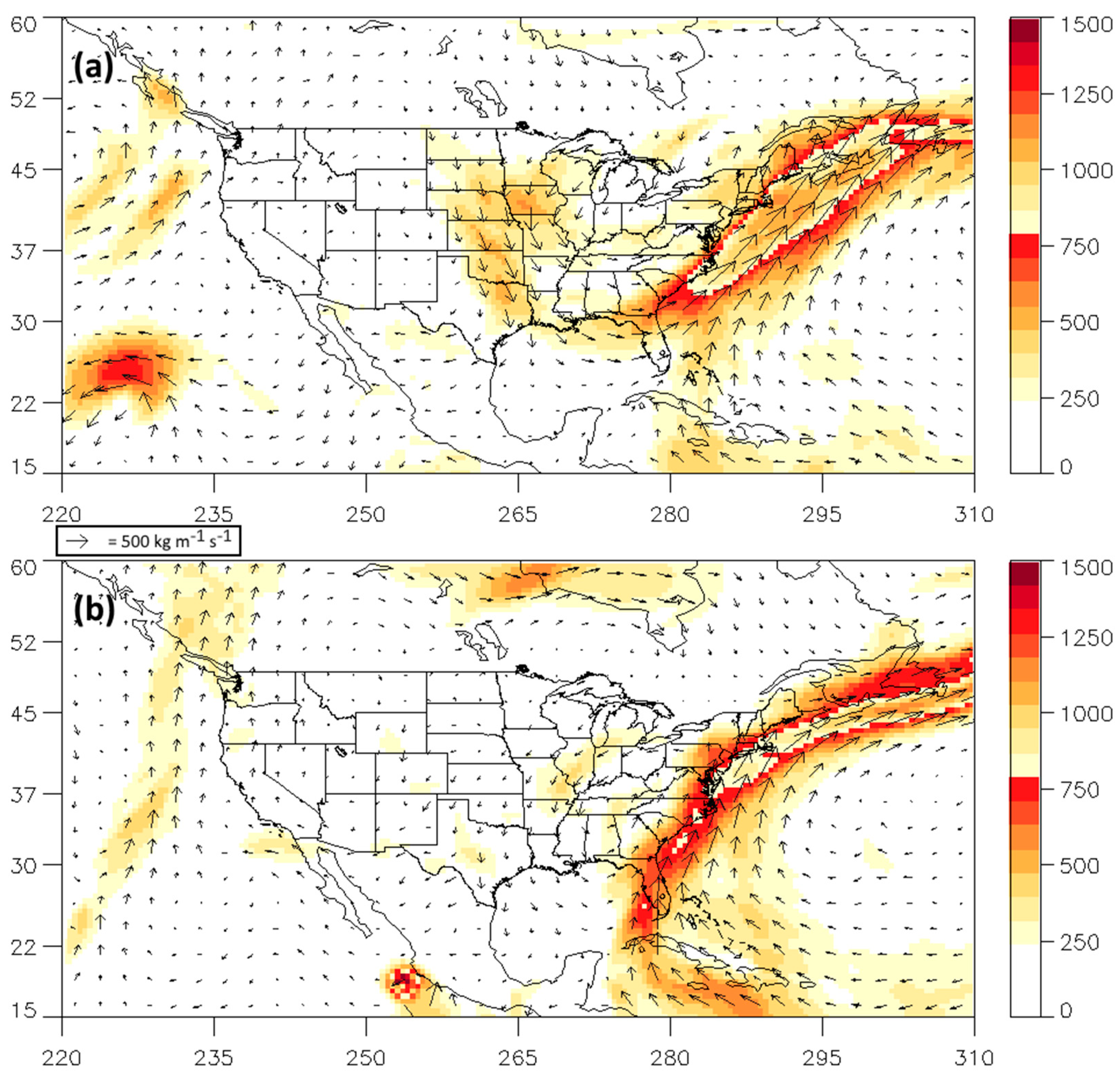3.2. Atmospheric Rivers and Rainfall Events Impacting Two River Basins in the Southern Appalachian Mountains during the ‘Recent’ Past (1 July 2009–30 June 2017)
Over the eight-year period, 192 AR events, totaling 1294 6-h periods, were detected out of 11,463 possible 6-h periods, or 11.3% of the time during the eight years study period rain was falling owing its origin to ARs (
Table 1). Seasonally, winter had the greatest and summer the fewest number of ARs. AR events in the summer and autumn were longer in duration than those in other seasons, primarily due to the tendency of cut-off lows to form and drift slowly eastward in the deep south of the U.S. during the warm months of summer and autumn. Extreme events (top 2.5%) occurred 43 and 24 times in the PRB and CRB, respectively (
Table 2). The significantly greater number of extreme events of the Duke GSMRGN was due to the shorter record length compared to the CHLRGN, over which the 2.5% was calculated. Of the AR-, tropical cyclone- (TC-), or other-influenced weather scenarios contributing to extreme rain events, a majority of the extreme rain events in both river basins were influenced by an AR. ARs influenced a significant majority of the extreme events observed in the CRB over the eight-year period.
The average duration of AR events (
Table 1) is relatively long compared to some other studies (e.g., Reference [
21]). There are three issues contributing to the longer average duration of our study using the GFS-based AR detection algorithm. First, an AR was considered ‘active’ in our study if it covered any portion of the IVT study domain (
Figure 2), which has a zonal width of ten degrees in longitude (centered on 83° W) and a meridional extent of five degrees in latitude (south of 35.5° N). Second, the imposed 12-h minimal threshold required for an event to be categorized as an AR in our study eliminated fast-moving events that may have contributed to lower average durations in other studies. Third, cool season extratropical storms generating ARs in the southeastern U.S. were at or rounding the upper-level trough as they transited through the IVT study domain. Hence, the storms often were pivoting, transitioning from eastward- to northeastward-propagating, while their ARs were covering the central and eastern half of the IVT study domain. Warm season extratropical storms generating ARs in the southeastern U.S. were slow-moving due to the equivalent barotropic characteristics of the environment and located far to the south of the primary baroclinic zone and jet stream.
A comparison of extreme events occurring in the two river basins over the eight year period showed some disagreement. Extreme events in the PRB did not also qualify as extreme events in the CRB, due to record length differences and the calculation of “extreme” over those periods of record. Seven of the 24 extreme events in the eight year period qualified as extreme in the CRB, but did not qualify as extreme in the PRB. All events were associated with an AR. Composites of six of the seven extreme events unique to the CRB are plotted in
Figure 3 and
Figure 4. One event (26 October 2010) involved a strong squall line that may have had a significant localized effect on the observed rainfall in both river basins and was omitted from further consideration.
Although differences in composite anomaly magnitudes (
Figure 4c,d) may not be reliable owing to the relatively small sample (
N = 6) used in creating the CRB composites, differences in orientation are significant. Composites of AR-influenced events in which ordinary precipitation was experienced in the PRB and extreme precipitation was experienced in the CRB (
Figure 3c and
Figure 4c) shows a significantly higher amplitude, neutrally-tilted trough and ridge compared to the composites of AR-influenced events in which extreme precipitation was experienced in the PRB (
Figure 3a and
Figure 4a). Differences in orientation of the large-scale wave imply different angles of incidence between the ARs, their associated low-level airflow, and local topography. Taken in their entirety,
Figure 3 and
Figure 4 suggest AR scenarios having southwesterly flow favor extreme rainfall events in the PRB, while AR scenarios having southerly flow inhibit them. Hence, extreme rainfall in the PRB appears possible only under specific conditions due to the rain-shadowing effect caused by its horizontal distance north and west of the Blue Ridge Escarpment and to the localized topography bordering the basin, particularly to the south of the PRB.
3.4. Connections between Rainfall, Atmospheric Rivers, and Landslides in the Southern Appalachian Mountains
The most active years for landslide days in western North Carolina were 2003, 2005, 2009, and 2013, in ascending order, while few landslide days occurred over an extended period from 1997 through 2002 (
Figure 6). Correlations among AR events associated with extreme ERTCs, extreme ERTCs, or extreme rainfall events (ExtRs) and landslide days (LDSL) were low, and insignificant, with Pearson correlation coefficients ranging from r = 0.09 (AR vs. extreme ERTC) to r = 0.27 (AR vs. LDSL,
Table 5). In general, extreme ERTC events were linked with at least one extreme rainfall event in the CRB during the period of the ERTC (r = 0.62,
Table 5) throughout the 21-year study period. It is clear when comparing the AR series with those of the other parameters over the 20+ year period (
Figure 6) that 2007–2008 represented a transition from ARs tracking with an opposite trend to LDSL, extreme ERTC, and ExtR events in the earlier period, to a change of AR trend being in phase with the trends of other events during the more recent post-2007–2008 period. Western North Carolina experienced a significant and extended drought during the 2007–2008 transition period [
46], which also corresponded to the period of a strong La Niña [
47] and strongly positive phase of the Pacific North American weather pattern toward the end of 2007 [
48]. Global and hemispheric weather patterns undoubtedly played some role in controlling AR activity influencing the southern Appalachians during the 20+ year study period, but their exact role awaits future study.
Landslide days were clustered in time (
Figure 7); calendar year 2003 was active early (six in March–May) and late (five in October–December) with the early period events linked via soil pre-conditioning and/or initiation to simultaneous ARs, extreme ERTCs, and ExtRs and the late period seemingly driven primarily by ExtRs. Landslide days in 2005 were linked primarily to landfalling TCs, extreme ERTCs, and ExtRs, with a noticeable dearth of ARs (
Figure 6), a period of transition from a weak El Niño to a weak La Niña [
47]. The number of extreme ERTCs in 2009 (and early 2010) was rather low, so most landslide days of that year (and early 2010) were conditioned or triggered either by individual strong ARs or ExtRs (
Figure 7). Calendar year 2013 was notable for significant rainfall in western North Carolina [
5]. Numerous landslide days of that year were linked to simultaneous ARs, extreme ERTCs, and ExtRs, with several of the heaviest rainfall events (January, May, and July) consisting of multiple ARs within a single extreme ERTC. The most extreme non-tropical-influenced ERTC of the 46 events over the 21 (or 20+) year study period occurred in July 2013 and was associated with seven landslide days (
Table 6). It must be noted over the study period that landfalling TCs were responsible for the greatest number of landslides in a day, even though their period of influence was brief (low number of landslide days).
Seasonally, extreme ERTCs and rainfall events (both event types are often linked) as observed by the CHLRGN were most likely to occur in autumn, while ARs peaked in the winter, and the number of landslide days was greatest in the summer, although the low range of the latter event type indicates a nearly even distribution across all seasons (
Table 7).
Combinations of event types contributing to the pre-conditioning or initiation of landslides are summed in
Figure 8 over the 20+ year study period during which 117 landslide days occurred. Landslide days were correlated with extreme ERTCs (
Table 5, r = 0.56,
p < 0.01), but when ARs, ExtRs, and extreme ERTCs coincided, we observed the greatest frequency of landslide days (21.4%). Landslide initiation and/or conditioning by ARs alone (18 LDSL, 15.4%) and by “Other” (19 LDSL, 16.2%) were the second highest contributors to the total number of landslide days of
Figure 8, but not significantly correlated as noted above. Several above-normal ERTC events and above-normal rain events contributed to a total of 16 landslide days. While significantly correlated, an extreme ERTC was not necessary for a landslide to occur.
Individual contributions of AR, ExtR and extreme ERTC event types to landslide days (
Figure 9a–c) show nearly identical frequencies, with 38% of landslide days (45 events) traced to AR- and ExtR-influenced events and 33% of landslide days (39 events) traced to extreme ERTC-influenced events. Coincident AR, ExtR, and extreme ERTC events accounted for 25 landslide days (
Figure 8), coincident AR and extreme ERTC events accounted for two landslide days, and coincident ExtR and extreme ERTC events accounted for six landslide days. Close inspection of the 25 landslide days found they corresponded to eight cases of coincident AR, ExtR, and extreme ERTC event types during the study period. Nine cases of the three coincident event types resulted in zero landslide days. Although rare, extreme ERTC events coupled with multiple occurrences of ARs or ExtRs during the period of the extreme ERTC event resulted in landslide days in four of the six cases. Recall that a single AR, ExtR, and/or extreme ERTC event was sometimes linked to multiple landslide days. As might be expected, frequencies of ARs and ExtR influencing landslide days are much lower than their influence of flooding events in the PRB found by Miller et al. [
5] (cf.
Figure 3d,e), ~64% and 50%, respectively, as might be expected since many factors, in addition to rainfall, are important for initiating landslides. Of the 475 AR, 79 ExtR, and 46 extreme ERTC events detected during the 20+ year study, 32 (6.7%), 30 (38.0%), and 29 (63.0%), respectively, played a role in at least one landslide day.
Aside from pre-conditioning western North Carolina for landslides via moistening of the soil, a second method for AR, ExtR, and extreme ERTC events to pre-condition the environment is through modification of the large-scale weather pattern. One example of this can be seen in the extreme ERTC event of July 2013 (ranked #2 in
Table 7, [
49]) that showed a high amplitude wave at the mid- and upper-troposphere (
Figure 10a,b), which is an unusual weather pattern for the middle of summer. The center of the Bermuda High at the 850 hPa level (
Figure 10c) was located well offshore of the U.S. east coast and a corridor of air having high precipitable water values bordered the western edge of the Bermuda High (
Figure 10d). An anomalously strong ridge over Maine and Nova Scotia at the upper- and mid-troposphere (
Figure 11a,b) was also evident. The trough geopotential height anomaly at the upper- and mid-troposphere located over the Mississippi River Valley was half as strong as the ridging to the northeast. The low-troposphere geopotential height anomalies at the 850 hPa level (
Figure 11c) were indicative of an unusually strong southeasterly, low-level airflow. The anomaly in precipitable water (
Figure 11d) had an unusually high available moisture bullseye to the north, just offshore of Maine and Nova Scotia, with a narrow corridor of higher-than-normal available moisture connecting the bullseye southward to the Gulf of Mexico.
We suggest that the anomalously strong ridging to the northeast and the connection of this region to the Gulf of Mexico, as suggested by the precipitable water composite mean and anomaly, was made possible by a series of ARs that were observed at the end of June (
Figure 12a) and at the beginning and middle of July 2013 (
Figure 12b). The IVT plumes (
Figure 12) represent two of four strong ARs detected between 29 June and 16 July 2013 that followed nearly identical pathways as they moved north and east, along the western periphery of the Bermuda High. We propose that the anomalously strong ridge to the northeast was a consequence of ridge-building provided via the diabatic process of latent heat release as the sub-tropical moisture of the ARs was converted to cloud water and precipitation. As the ridge continued to build, the large-scale weather pattern became increasingly stagnant, allowing for the repeated propagation of successive ARs over the same pathway and increased ridge-building through continued latent heating. Hence, the stagnation of the large-scale weather pattern due to the ridge-building to the north via latent heat release, provided a mechanism for ‘training’ rainfall events over the southern Appalachian Mountains that pre-conditioned the soil and/or triggered landslides. This particular example of ‘training’ large-scale rainfall events was responsible for seven landslide days in July 2013 (
Table 6). Following the ‘Maya Express’ nomenclature of Dirmeyer and Kinter [
50], which implies a dynamic system, it is proposed that the large-scale weather mechanism describing the July 2013 event be designated as a ‘Maya Corridor.’ As a technology corridor describes a fixed zone along an interstate, a ‘Maya Corridor’ implies a fixed zone of significant meridional extent moving moisture from the subtropics into the mid-latitudes of the eastern U.S., making conditions favorable for flooding and landslides. Based on this example, AR, ExtR, and extreme ERTC events, under favorable large-scale patterns, are capable of providing the ridge-building necessary to halt the propagation of the large-scale wave and establish a ‘Maya Corridor.’ The third ranking extreme ERTC event of mid-November 2013 (
Table 6) provides another example of a variation on the ‘Maya Corridor’ theme from the 20+ year study period involving seven ARs (not shown), but resulted in only a single landslide day, likely due to the relatively low background moisture typical of winter.
